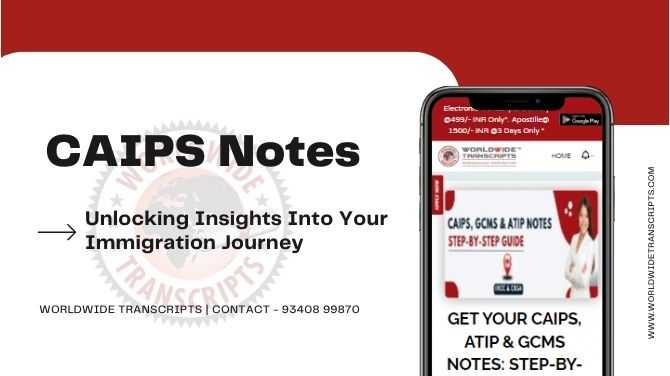
Caips Notes: Unlocking Insights Into Your Immigration Journey

Imagine you've submitted an immigration application and are eagerly awaiting the decision. Days turn into weeks, weeks into months, and the suspense continues to grow. During this waiting period, you may find yourself wondering about the progress of your application, the factors being considered, and the reasons behind any delays. Fortunately, there is a tool that can provide you with invaluable insights into your immigration journey - CAIPS notes.
Introduction
In this article, we will explore the world of CAIPS notes and understand their significance in the immigration process. From deciphering their content to leveraging them effectively, CAIPS notes can be an essential resource for applicants seeking transparency and understanding.
What are CAIPS notes?
CAIPS (Computer Assisted Immigration Processing System) notes are detailed records maintained by the Canadian immigration authorities for each individual's application. These notes encompass a comprehensive log of interactions, assessments, decisions, and updates related to your immigration case. They serve as a window into the behind-the-scenes processes involved in assessing your application.
Why are CAIPS notes important?
The importance of CAIPS notes cannot be overstated. They offer a glimpse into the inner workings of your immigration application, shedding light on its progress, potential issues, and decision-making factors. By obtaining and analyzing these notes, you can gain a better understanding of your case's strengths, weaknesses, and areas that require attention.
How to request CAIPS notes?
To obtain your CAIPS notes, you can submit a request to the Canadian immigration authorities. The request should be made through the right channels, accompanied by the necessary documentation and fees. It is crucial to ensure accuracy and completeness when making the request, as any errors might result in delays or incomplete information.
Understanding the contents of CAIPS notes
Once you receive your CAIPS notes, it's essential to understand the different sections and what they entail. The contents typically include:
Personal information
This section encompasses details such as your name, date of birth, passport information, and contact information. It serves as a reference point to ensure the correct application is being reviewed.
Immigration history
Here, you will find information about your previous immigration history, including any past applications, visas, or permits. It provides a comprehensive overview of your journey through the immigration process.
Documentation
This section highlights the documents you have submitted as part of your application. It helps you verify if all the required documents have been received and are being considered.
Officer's notes
Arguably the most crucial section, the officer's notes offer insights into the assessments, observations, and decisions made by the immigration officer reviewing your case. These notes can provide critical clues about the strengths and weaknesses of your application.
Analyzing CAIPS notes
Once you have your CAIPS notes in hand, the next step is to analyze them effectively. Here are some points to consider:
Identifying mistakes or discrepancies
By carefully reviewing the officer's notes, you can identify any errors, discrepancies, or misunderstandings that might have occurred during the assessment process. These findings can be crucial in rectifying any misunderstandings and providing additional supporting evidence if needed.
Assessing application progress
The notes often contain timestamps and references to various stages of the application process. Analyzing these details can help you gauge the progress of your application and estimate the time it may take for a decision to be reached.
Preparing for interviews or appeals
In some cases, CAIPS notes might reveal that an interview or appeal is imminent. By studying the officer's comments and observations, you can better prepare yourself for these upcoming interactions, ensuring you address any concerns effectively.
Interpreting CAIPS notes
Reading and understanding CAIPS notes can be challenging due to the presence of immigration jargon, abbreviations, and specific terminology. To interpret the notes accurately, consider the following tips:
Immigration jargon and abbreviations
Familiarize yourself with common immigration terms, abbreviations, and acronyms used in the context of CAIPS notes. This knowledge will enable you to decipher the notes more effectively and understand the officer's comments in detail.
Decoding officer's comments
The officer's notes might contain specific comments, observations, or requests related to your application. Pay close attention to these remarks as they can provide valuable insights into the officer's thought process and expectations.
How to use CAIPS notes effectively
To make the most of your CAIPS notes, consider the following strategies:
Seeking professional advice
If you find the content of your CAIPS notes confusing or overwhelming, it's wise to seek professional advice from an immigration consultant or lawyer. These experts can help you interpret the notes accurately and guide you on the best course of action.
Addressing concerns or issues
If the CAIPS notes highlight any concerns or issues with your application, it's crucial to address them promptly. Review the officer's comments and take appropriate steps to rectify any deficiencies, provide additional evidence, or address misunderstandings.
Improving future applications
CAIPS notes can offer valuable insights for improving future applications. By analyzing the weaknesses or shortcomings identified in the notes, you can enhance your chances of success in subsequent immigration endeavors.
Conclusion
In conclusion, CAIPS notes serve as a treasure trove of information for individuals navigating the Canadian immigration process. They provide a comprehensive record of your application's progress and offer insights into the decision-making factors at play. By understanding, analyzing, and utilizing CAIPS notes effectively, you can take a proactive approach to your immigration journey and increase your chances of success.
Frequently Asked Questions (FAQs)
Q1: Can I request CAIPS notes for any type of Canadian immigration application?
Yes, CAIPS notes can be requested for various types of Canadian immigration applications, including study permits, work permits, permanent residence applications, and more.
Q2: How long does it typically take to receive CAIPS notes after making a request?
The processing time for CAIPS notes requests can vary. It can take anywhere from a few weeks to a few months to receive the notes, depending on the workload and processing times of the immigration authorities.
Q3: Are CAIPS notes considered confidential information?
Yes, CAIPS notes contain sensitive and confidential information related to your immigration application. It is essential to handle them with care and not share them with unauthorized individuals.
Q4: Can I appeal a decision based on the information found in CAIPS notes?
Yes, if the CAIPS notes reveal errors or concerns that may have affected the decision on your application, you may have grounds for an appeal. Consulting with an immigration professional is recommended to assess your options.
Q5: How often should I request updated CAIPS notes for an ongoing application?
It is generally recommended to request updated CAIPS notes every few months to keep track of the progress and any updates related to your application. However, the frequency may vary depending on the complexity and stage of your application.
Author Bio
Worldwide Transcripts is an educational service provider that helps you to get your transcripts from universities, Apostille of Documents, Embassy Attestation, Translation Services, MOI, GCMS Notes, ATIP Notes, etc. We have world-class services and world-class trusts.
Article Comments
No Comments!
At present there are zero comments on this article.
Why not be the first to make a comment?
Similar Articles
Search Pages
User Upgrade
account to full use of editor,
Including hyperlinks
Article Categories
There are zero sub-categories in this parent category.
There are zero sub-categories in this parent category.

















